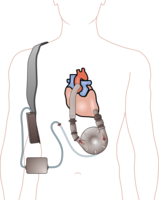
Photo from wikipedia
We read with interest the letter from the colleagues Loardi and Zanobini and would like to thank them for their useful comments on our recently published paper on the effects… Click to show full abstract
We read with interest the letter from the colleagues Loardi and Zanobini and would like to thank them for their useful comments on our recently published paper on the effects of concomitant aortic valve (AoV) procedures during left ventricular assist device (LVAD) implantation in patients enrolled in the ISHLT Mechanically Assisted Circulatory Support (IMACS) Registry.1 The negative haemodynamic effects of untreated moderate-to-severe aortic regurgitation (AR) could be severe, while less severe AR might be less cumbersome.2 Our results clearly demonstrated that a concomitant AoV procedure was an independent risk predictor for all-cause mortality post-LVAD implantation. Patients with less severe AR who underwent an AoV procedure had a worse survival compared to those without an AoV procedure, while only in patients with moderate-to-severe AR no survival differences were observed. These results suggests that the positive effects of resolving AR overcome the incremental risk associated with a concomitant AoV procedure, while this was not the case in patients with less severe AR. We agree that an aneurysm of the ascending aorta could induce or exacerbate pre-existing AR. However, albeit the long-term LVAD support might induce a progressive ascending aorta dilatation, data regarding this phenomenon are still very scarce.3 Unfortunately, no data regarding the development of ascending aorta aneurysms were available in the IMACS Registry. In patients with reduced right ventricular (RV) function post-LVAD implantation, longlasting AR increases the risk for all-cause mortality. Additionally, it has been shown that long-lasting AR has a negative effect on RV function. However, considering all LVAD patients, AR does not affect the overall survival, which is in line with our results. Specific sub-analysis in patients with a compromised RV function could give some answers, but this is not yet done. The largest survival gap between patients with and without a concomitant AoV procedure occurs in the first 3 months post-LVAD implantation. We agree that the most likely explanation is the prolonged surgical time with detrimental effects on RV function and increased risk of perioperative morbidity and mortality.4 Once the acute phase is past, there will be a new haemodynamic and clinical equilibrium which will be much better tolerated. We agree that Impella support can induce AoV damage leading to more unplanned AoV procedures.5 However, the preoperative use of Impella support was not available in the IMACS Registry. During the first 3 months, AoV repair patients died more often from a major infection compared to the AoV replacement group. Patients with an AoV repair have a prolonged surgical time and spend more time in the intensive care unit ward, which is associated with an increased risk for sepsis. An AoV replacement procedure is associated
Journal Title: European Journal of Heart Failure
Year Published: 2021
Link to full text (if available)
Share on Social Media: Sign Up to like & get
recommendations!